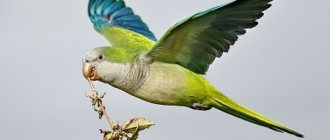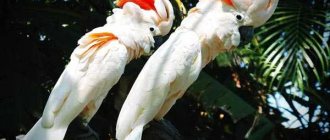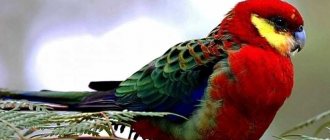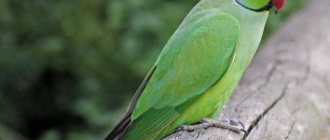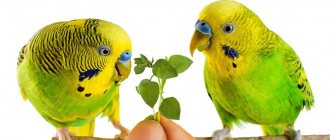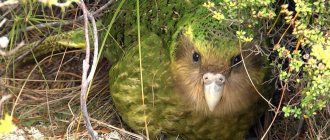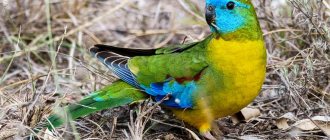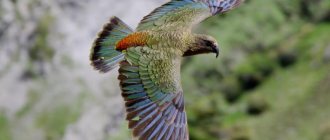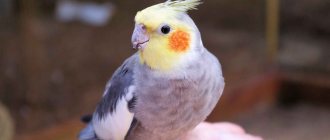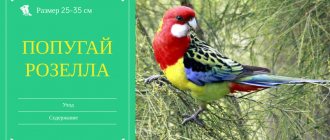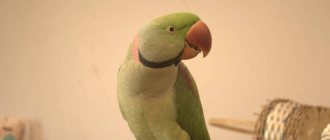Description of the parrot
Appearance
Quakers are classified as medium-sized parrots. The body length of an adult bird is about 29-30 cm, and the weight reaches 80-140 grams.
Appearance of a monk parrot
Parrots of this species have inconspicuous camouflage, allowing them to hide from predators in the foliage of trees. The back of the neck, back, and tail are colored green. The bird's forehead, throat, chest and abdomen are light gray, the latter with a greenish tint. The brightest part of the body is the flight feathers of the wings in blue-blue tones. The strong, rounded beak is straw yellow, and the irises of the monks' eyes are brown. The tail is wedge-shaped, stepped, long, dark green in color.
Sexual dimorphism in these parrots is practically not expressed. Males are larger, have longer tail feathers, and a more massive body than females.
In addition to the natural one, breeders have bred other unusual colors of the Kalita parrot. The green color in their plumage is replaced by blue, yellow, white or brown. These are quite rare mutations, more common among hobbyists in the homeland of parrots.
Intelligence and character
The monk parrot has a cheerful, friendly disposition and a sharp mind. The bird's intelligence allows it to be taught commands, tricks and tricks. Quakers love to play, learn new things, and make good contact with people. These qualities make them excellent students.
Monk Parrot Character
The habits of a pet released for a walk around the room are very unusual. Parrots of this species tend to hide in a secluded place everything they consider valuable or interesting. In their cache you can find buttons, cufflinks, beads, chains, various hair accessories, stationery and much more. In addition, birds love to soak various objects in water. These could be pieces of paper, fallen feathers, or food.
When keeping birds of different species, you need to be careful. During a walk, the monk parrot behaves peacefully and plays freely with other birds. But as soon as an unlucky neighbor steps onto Quaker territory, he will be attacked. These pets are great owners, zealously defending the boundaries of their cage. When invaded, they behave aggressively not only with relatives, but even with the owner.
Kalita have a deep attachment to a person and react painfully to prolonged absence or lack of attention from the owner.
A disappointed bird may forever lose trust in people. In this case, the parrot will behave aggressively, bite, and scream often. Therefore, the choice of a pet must be taken with full responsibility, because giving the pet later in second hands means dooming it to a lonely and unhappy existence.
Parrot learning abilities
Kalita and Quaker
The monk's parrot owes its unusual name to its coloring, which resembles the cassock of a group of clergymen called Quakers. The bird appears to be wearing a green cloak with a hood and a gray cap on its head.
Kalita is the name of the genus translated from Latin into Russian. The monk parrot is its only representative. There are four subspecies of birds that inhabit different areas of South America and differ slightly only in size.
Features of the view
These are noisy birds, prone to making sharp, frightening sounds for almost any reason, be it anxiety or interest in something. It is this tendency that is the characteristic feature that allows one to unmistakably distinguish the monk from other varieties of parrots. These are very domestic birds that certainly return to their habitat, be it the owner’s house in captivity or a favorite place in the open air.
Quakers are the only species of parrot that prefers to build nests for laying eggs. Like many birds, their nests are built from natural material - tree branches. The location of such unusual dwellings for parrots can be not only trees, but also the roofs of houses, overpasses, supports of bridges and power lines.
Also, monk parrots can take a liking to hollows and rocks, placing their family nests on them. Chicks appear in them no more than twice during the year. The natural color of parrots of this species is green. But artificially, as well as as a result of mutations, it was possible to breed individuals of different colors:
- blue - the upper plumage, including wings and paws, has various color shades of blue, natural green is absent;
- blue - natural green color replaced rich blue; the appearance of the birds is unusual;
- orange - unique specimens of rich color, which are very difficult to hide in the green leaves.
Habitat in the wild
The monk parrot is native to South America. Depending on the subspecies, Kalita inhabits the southeastern regions of Brazil, the lands of Argentina, Uruguay, Paraguay and Bolivia. More than a hundred years ago, birds were brought to European countries. Now bird colonies can be found in Italy, Belgium, Greece, the Netherlands, Great Britain and even Japan.
Habitat of a parrot in the wild
It is interesting that if previously the natural habitats of the monk’s parrot were fields, steppes or deciduous forests, over time the birds have perfectly adapted to living in large cities. In some of them, Quakers live like pigeons, without fear of people, and sometimes cause the latter a lot of trouble. For example, parrots make huge nests on poles or power lines. In rural areas, flocks of feathered pests raid plantations of cultivated plants, devastating them.
Where does he live?
Unlike many other exotic birds, Quaker parrots are not in danger of extinction. This is a common species of birds, which in their natural habitat can even be considered pests, because they fly into gardens and fields and spoil the harvest. Birds love warm climates, dense forests with an abundance of vegetation, where they can hide from enemies, build nests and where there is enough food.
The largest number of monk parrots is in Barcelona: they are as common there as our ordinary rock pigeons or sparrows. Brazil, Uruguay, Argentina are all natural habitats for birds. They are found in forests in large flocks, but often fly to cities, where there is a lot of tasty and affordable food, and there are much fewer predators.
Care and maintenance at home
Cell
The space for a new tenant in your home should be spacious enough. The optimal cage dimensions are from 60x80x100cm. It should also be all-metal, with rods at least 1.5-2mm thick and a pull-out tray. Inside, the bird’s home must be equipped with several wooden perches, an automatic drinker, three feeders for different types of food, and interesting toys.
Diet
The nutrition of a Quaker parrot should not be limited to just grain mixture. Although the latter forms the basis of the diet, the birds’ menu also necessarily includes juicy fruits, berries, greens, twigs, and animal food.
What to feed your parrot
The monks' favorite fruit is apples. With interest, your feathered friend will try plums, pears, apricots, kiwis, and bananas. From vegetable crops, offer the bird carrots, beets, pumpkin, zucchini, and tomatoes.
Birds are not allowed to eat fried, smoked, salted foods from the human table, or confectionery. Some fruits and vegetables are also prohibited:
- persimmon;
- avocado;
- mango;
- papaya;
- garlic;
- eggplant;
- radish;
- potato.
The constant presence of mineral supplements in the cage is very important. As the latter, an industrial mixture or cuttlefish shell or chalk is used.
Diet for a monk parakeet
Kalita loves to chew on everything. To prevent your pet from damaging the furniture in the house, give it fresh twigs and wooden toys to wear down its beak. The best option is to install a special stand near the cage, where there will be a lot of interesting things for the bird to enjoy.
Hygiene and water procedures
The sanitary conditions of the habitat are very important for the health and well-being of your pet. Wash the cage and all accessories once or twice a week. Renew food and drink daily, as well as the bedding at the bottom of the bird's house. Do a thorough cleaning every month, during which you carry out disinfection to avoid infecting your pet with fungal or parasitic diseases.
Quakers love to splash in the water. To do this, you should purchase a special bathing suit and install it in the cage. The liquid in it is changed as it gets dirty, but at least once a day.
Training, flying and games
The monk's parrot is a lively, active pet. To maintain good physical shape, as well as the psychological comfort of a Quaker, he needs daily walks around the room. Birds experience long-term imprisonment hard, they become sad, they can start plucking feathers or even injure themselves.
Kalita - Interesting facts about the species | Species of the Kalita parrot
This species of birds is constantly studying, gnawing and searching for something. Therefore, your pet needs to purchase more toys that develop intelligence. Give them one at a time, and promptly replace those that have become unusable with new ones. Inside the cage you can install a rope, a ladder, a swing, and a mirror. Place a game stand made of branches next to it.
The mental abilities of parrots are equated to the intelligence of a young child. Consequently, such a highly organized creature requires appropriate education and training for life in society. Otherwise, an aggressive, uncontrollable, noisy bird will cause a lot of trouble for others.
Training a pet begins with gaining trust and taming it in your hands. Reinforcement should only be positive - use the bird’s favorite treat. Do not put pressure on your pet, act slowly, the main thing is not to scare the parrot. Once your pet has mastered the basic commands, you can begin teaching tricks and talking.
Kalita - All about the species of parrots | Type of parrot - Kalita
Nutrition
The Kalita parrot loves to eat well. He loves to eat vegetables and fruits. Birds' diet must include seeds and grain feed. With a sedentary life, they easily gain weight and may suffer from obesity. To avoid this, you need to stop feeding your pet seeds of various oilseeds. You should also exclude legumes and nuts from the menu. Recommended vegetables include cauliflower, carrots and corn. Fruits should include bananas and apples. They must be fresh and thoroughly washed with warm water.
It is useful to give exotic birds greens: spinach and parsley. You need to monitor its quantity to avoid possible problems with the gastrointestinal tract. To strengthen the dental and skeletal systems, the pet is fed cottage cheese. You can add semolina and crushed pumpkin seeds to it. This mixture is best given during the breeding season of parrots. Prohibited foods include salt, chocolate, white bread and carbonated drinks. Harmful components can negatively affect the bird’s body, so you need to monitor its diet.
Branches of trees and shrubs are useful for birds. It is not advisable to give pine needles, because... it contains a large amount of tannin. Resin in a small dose is beneficial for the pet's body. Drinking water should always be clean and fresh. You can add a few drops of lemon juice to it. You cannot feed your parrot running water because it contains harmful chemicals. It is recommended to add nutritional supplements to your diet. These include mineral sand, stone and limestone. They contain a large amount of vitamins. Before doing this, you should consult a specialist. He will determine the required dose and frequency of use.
Seeds and grains are the main components of a balanced diet for the Kalita parrot. It is advisable to prepare the grain mixture yourself. For this purpose, a large number of seeds of various plants are used. Typically these include millet, oats, sunflowers and flax. This composition is considered the basis of bird nutrition. The mixture can be mixed with boiled rice, with the addition of berries and pieces of fruits and vegetables. Newborn chicks are fed finely grated carrots with egg yolk. Sometimes a bird may refuse a certain type of food. The owner must gradually accustom the pet to different types of food.
Diseases and prevention
Like all birds, Quakers can suffer from infectious, fungal and parasitic diseases. Depending on the cause, the first signs are different.
The most common of them:
- runny nose;
- sneezing;
- stool disorder;
- lethargy of the bird;
- feather falling out.
In advanced cases, food refusal, exhaustion, fever and other severe symptoms occur. If measures are not taken in time to save your pet, it can quickly die. If a Quaker shows signs of ill health, it is necessary to immediately show it to an ornithologist to determine the cause and prescribe treatment.
As preventive measures, clean the cage in a timely manner, diversify your pet’s diet, communicate with it more, and treat your little friend with love and care.
Parrot
